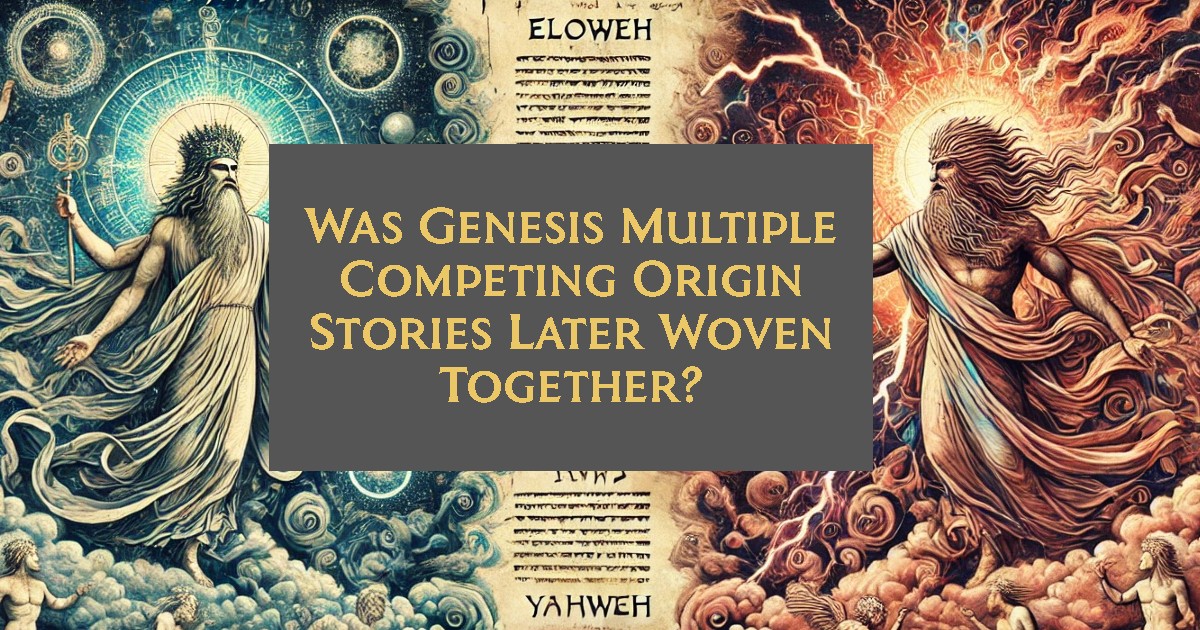The book of Genesis stands at the heart of Judeo-Christian cosmology, yet textual and historical analysis suggests it may not have originated as a single, unified narrative. Instead, multiple, sometimes competing, traditions appear to have been woven together by later editors, smoothing over contradictions and theological tensions. A close examination of early Hebrew manuscripts, non-canonical sources, and comparative mythology provides compelling evidence that Genesis was shaped through centuries of redaction and synthesis.
The Double Creation Accounts: A Merging of Two Traditions
One of the most apparent indications of Genesis’s composite nature lies in its two distinct creation narratives:
- Genesis 1:1–2:3 (The Priestly Account): This version presents a structured, cosmic order in which God (Elohim) speaks creation into existence over six days and rests on the seventh. Humans—both male and female—are created simultaneously as the pinnacle of creation (Genesis 1:27).
- Genesis 2:4–25 (The Yahwist Account): This account, often attributed to the older Yahwist (J) source, presents a more anthropomorphic deity (Yahweh Elohim), who personally forms Adam from the dust before creating plants, animals, and later, Eve from Adam’s rib. The order of creation is different, suggesting a separate tradition.
This textual duplication suggests that editors of the Hebrew Bible did not eliminate divergent traditions but preserved them within a single text.
Earliest Hebrew Textual Evidence
A comparison of pre-Masoretic Hebrew fragments, such as those found among the Dead Sea Scrolls, reveals minor variations in Genesis’s wording. These variations indicate an evolving textual tradition rather than a static, divinely dictated text.
For instance, Genesis 1:27 in the Leningrad Codex (the oldest complete Hebrew Bible, 1008 CE) states:
“וַיִּבְרָא אֱלֹהִים אֶת־הָאָדָם בְּצַלְמוֹ בְּצֶלֶם אֱלֹהִים בָּרָא אֹתוֹ זָכָר וּנְקֵבָה בָּרָא אֹתָם”
(Wayyivra Elohim et-ha’adam b’tzalmo, b’tzelem Elohim bara oto, zakhar u’n’kevah bara otam.)
“And God created man in His own image, in the image of God He created him; male and female He created them.”
Yet Genesis 2:7 (same manuscript) describes:
“וַיִּיצֶר יְהוָה אֱלֹהִים אֶת־הָאָדָם עָפָר מִן־הָאֲדָמָה”
(Wayyitzer Yahweh Elohim et-ha’adam afar min-ha’adamah.)
“And Yahweh God formed man from the dust of the ground.”
The shift from Elohim to Yahweh Elohim and the differing method of creation suggests separate source material.
Traces of Polytheism in Early Genesis Texts
A fascinating feature of early Genesis is its traces of a polytheistic past, later overwritten by monotheism:
Genesis 1:26 – Who is “Us”?
“וַיֹּאמֶר אֱלֹהִים נַעֲשֶׂה אָדָם בְּצַלְמֵנוּ כִּדְמוּתֵנוּ”
(Vayomer Elohim, Na’aseh adam b’tzalmenu kid’mutenu.)
“And God said, ‘Let us make man in our image, after our likeness.’”
The plural “let us make” and “in our image” suggest a divine council, an idea consistent with Canaanite mythology (see Ugaritic texts referring to El and his divine assembly). Later Jewish and Christian interpretations recast this as a reference to the Trinity or angels, but earlier textual evidence suggests a polytheistic background.
This notion is reinforced in Psalm 82, where God (Elohim) judges other gods:
“אֱלֹהִים נִצָּב בַּעֲדַת־אֵל בְּקֶרֶב אֱלֹהִים יִשְׁפֹּט”
(Elohim nitzav ba’adat El, b’kerev elohim yishpot.)
“God stands in the divine assembly; He judges among the gods.”
This suggests the earliest Hebrew tradition retained vestiges of divine plurality, which later monotheism sought to obscure.
The Flood Narrative: A Fusion of Two Flood Stories
The Genesis flood story (Genesis 6–9) contains apparent contradictions and repetitions, signaling an editorial merger of two flood traditions. Consider these duplicate details:
- Genesis 6:19–20 (Priestly): Noah is instructed to bring two of every animal.
- Genesis 7:2–3 (Yahwist): Noah is instructed to bring seven pairs of clean animals and two of unclean ones.
Additionally, the name for God fluctuates between Elohim (P source) and Yahweh (J source), further supporting the dual-source hypothesis.
Scholars recognize these inconsistencies as evidence of redaction, a process likely finalized during the Babylonian Exile (6th century BCE).
4. Non-Canonical Parallels: Mesopotamian and Jewish Apocrypha
Many elements of Genesis parallel older Mesopotamian myths, suggesting cross-cultural borrowing:
- Enuma Elish (Babylonian creation epic, c. 18th century BCE) describes Marduk creating order from chaos, similar to Genesis 1:2’s depiction of a tohu vavohu (“formless and void”) world.
- Atra-Hasis (c. 17th century BCE) describes a god-formed man from clay, reminiscent of Genesis 2:7.
- The Book of Enoch (c. 3rd–1st century BCE) expands on Genesis’s sons of God (Genesis 6:1–4), suggesting an older tradition edited out of the final biblical text.
Woven Tapestry of Competing Traditions
Rather than a single, divinely revealed text, Genesis appears to be the result of textual evolution, merging older traditions into a unified narrative. This does not necessarily negate its theological value but invites deeper inquiry into the development of the biblical canon.
Understanding these layered origins enhances our appreciation for Genesis—not as a static revelation, but as a living document shaped by centuries of human experience, cultural exchange, and theological refinement.
Key Sources
Richard Elliott Friedman, Who Wrote the Bible?
John J. Collins, Introduction to the Hebrew Bible
Michael Heiser, The Unseen Realm
Robert Alter, The Hebrew Bible: A Translation with Commentary
Frank Moore Cross, Canaanite Myth and Hebrew Epic
James Pritchard, Ancient Near Eastern Texts Relating to the Old Testament
Ugaritic Texts (KTU 1.1–1.6)
Leningrad Codex (BHS – Biblia Hebraica Stuttgartensia)
Dead Sea Scrolls (4QGenesisb, 4QGenesis-Exodus)
Would love to hear your thoughts! Does this challenge or enrich your understanding of Genesis? 🚀

